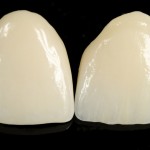
Implant supported single crowns are becoming and increasingly popular restorative option. While metal- ceramic crowns are regularly used an increasing focus on aesthetics has seen a move towards all-ceramic crowns as the choice for restoration.
The aim of this review was to evaluate the survival and technical complication rates of all-ceramic implant-supported single crowns.
Methods
Searches were conducted in the Medline, Embase, and the Cochrane Central Register of Controlled Trials (CENTRAL) databases for prospective or retrospective studies examining implant supported all ceramic single crowns with at least 15 patients and a follow up period of 12 months or more.
Two reviewers independently screened and selected studies and extracted data. Risk of bias was assessed using the Cochrane tool for randomised controlled trials (RCTs) and the Newcastle-Ottawa Scale for non-randomised studies. Survival rates of implants and restorations plus technical complication rates of single crowns were calculated. Statistical analysis was performed using a negative binomial distribution model to calculate 5- and 10-year survival and complication estimates.
Results
- 41 studies (7 RCTs, 20 prospective and 12 retrospective studies with 2 of unstated design) were included.
- The average follow-up was 4.55years (range 1 to 18.5yrs).
- All-ceramic SCs were fixed on titanium or zirconia implants using screw retention or cementation.
- A majority of the studies (32) used titanium implants.
- Ninety-five SCs of the initially included 2,390 SCs were reported to be failures (3.97%).
| Implant survival | Crown survival | |
| 5 years | 95.3% (95% CI: 90.6%-97.7%) | 93.0% (95%CI: 86.6%-96.4%) |
| 10 years | 96.2% (95% CI: 95.1%-97.1%) | 94.4% (95% CI: 91.1%-96.5%) |
| Technical complication rates | ||
| 5 years | 10 years | |
| Chipping | 9.0% (95% CI: 5.4%-14.8%) | 2.7% (95% CI: 2.1%-3.5%) |
| Framework fractures | 1.9% (95% CI: 0.7%-4.9%) | 1.2% (95% CI: 1%-1.5%) |
| Screw loosening | 3.6% (95% CI: 1.6%-8.4%) | 5.2% (95% CI: 3.6%-7.5%) |
| Decementations | 1.1% (95% CI: 0.4%-2.8%) | N/A |
| Estimated failure rates | 5 years | 10 years |
| per 100 crown years | 1.45 (95%CI; 0.73, 2.87) | 0.57 (95%CI; 0.35, 0.94) |
| per 100 implant years | 0.97 (95%CI; 0.48, 1.97) | 0.38 (95%CI; 0.29, 0.51) |
Conclusions
The authors concluded: –
All-ceramic implant-supported SCs showed-with the exception of a resin-nano-ceramic (RNC) material-high survival rates. However, failures and technical complications occurred which have to be considered when informing patients on the treatment with implant-supported all-ceramic SCs.
Comments
The authors have conducted a broad search for this review and included RCTs, prospective and retrospective studies. While including different study designs makes use of all the available information potential biases associated with the study designs need to be taken into account. Retrospective studies for example are likely to suffer from selection bias and possibly missing data and there is some acknowledgement of problems with retrospective studies in the discussion. Ideally a comparison between metal-ceramic and all-ceramic crowns should be undertaken as a RCT but the majority of included studies are prospective studies. The authors indicate that they did assess dropouts and data on individual study drop pout is provided but it is not clear how they accounted for this in their analysis. Typically, it is anticipated that dropouts have poorer outcomes that patients retained in the study. Essentially the review suggests that overall survival rates for all-ceramic are similar to metal-ceramic ones but that technical complications appear to be higher.
Links
Primary Paper
Rabel K, Spies BC, Pieralli S, Vach K, Kohal RJ. The clinical performance of all-ceramic implant-supported single crowns: A systematic review and meta-analysis. Clin Oral Implants Res. 2018 Oct;29 Suppl 18:196-223. doi:10.1111/clr.13337. PubMed PMID: 30306684.
Other references
Dental Elf = 19th Sep 2016
Dental Elf = 12th Aug 2015

[…] All-ceramic implant-supported single crowns […]